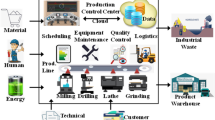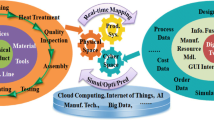Abstract
Personalized production is a manufacturing concept relevant to the fourth industrial revolution, which can satisfy various customer needs inexpensively. There are three main hurdles to the efficient implementation of this concept: access, cost, and performance. This paper proposes a digital twin-based cyber physical production system (CPPS) architectural framework that overcomes the performance hurdle. The proposed architectural framework comprises five services that are solutions to the performance hurdle of personalized production, and it operates on information based on the proposed product, process, plan, plant, and resource (P4R) information model. This information model is manufacturing abstraction for personalized production and is presented on a detailed level with object-orientation and the “type and instance” concept. Whereas previous studies on the digital twin concept considered one or several facilities and focused on the development of independent applications, this study focuses on the digital twin as a core technological element of the entire system and analyzes CPPS design and its operation from the system-of-systems perspective. The application of the digital twin-based CPPS to a micro smart factory (MSF) provides an advanced solution for the personalized production of various products. An average makespan improvement of ~ 26.87% was achieved using the implemented CPPS services in the MSF.


















Similar content being viewed by others
References
Yao X, Lin Y (2016) Emerging manufacturing paradigm shifts for the incoming industrial revolution. Int J Adv Manuf Technol 85:1665–1676
Wiktorsson M et al (2018) Smart factories: South Korean and Swedish examples on manufacturing settings. Procedia Manuf. 25:471–478
Doukas M, Psarommatis F, Mourtzis D (2014) Planning of manufacturing networks using an intelligent probabilistic approach for mass customised products. Int J Adv Manuf Technol 74:1747–1758
Yao S et al (2007) Computer-aided manufacturing planning for personalized production: Part 1, framework. Int J Adv Manuf Technol 32:194–204
Mai J et al (2016) Customized production based on distributed 3D printing services in cloud manufacturing. Int J Adv Manuf Technol 84:71–83
Kumar A (2007) From personalized production to mass personalization: a strategic transformation. Int J Flex Manuf Syst 19:533
Zhao WB, Jung YJ, Park KT, Noh SD, Kim H, Son JY (2016) Design and implementation of a factory-level CPS for a micro smart factory. ACDDE, Jeju
Du X, Jiao J, Tseng MM (2006) Understanding customer satisfaction in product customization. Int J Adv Manuf Technol 31:396–406
Son J-Y et al (2015) IoT-based open manufacturing service platform for mass personalization, J. KICS 33:42–47
Engel G, Greiner T, Seifert S (2018) Ontology-assisted engineering of cyber–physical production systems in the field of process technology. IEEE Trans Ind. Informat. 14:2792–2802
Kim H-J (2018) Bounds for parallel machine scheduling with predefined parts of jobs and setup time. Ann Oper Res 261:401–412
Hakan K, Farahani S, Pilla S (2019) Feasibility study for manufacturing CF/epoxy–thermoplastic hybrid structures in a single operation. Procedia Manuf 33:232–239
Qi Q, Fei T (2018) Digital twin and big data towards smart manufacturing and industry 4.0: 360 degree comparison. IEEE Access 6:3585–3593
Brecher C et al (2012) Integrative production technology for high-wage countries. In: Integrative production technology for high-wage countries. Springer, Berlin, pp 17–76
Lee J, Bagheri B, Kao H-A (2015) A cyber-physical systems architecture for industry 4.0-based manufacturing systems. Manufact Lett 3:18–23
Shah D, Patel P (2018) Productivity improvement by implementing lean manufacturing tools in manufacturing industry. Int Res J Eng Technol 5(3):3–7
Lee J-H, Kim H-J (2016) Makespan analysis of loT switching period in cluster tools. IEEE Trans Semicond Manuf 29:127–136
Liu Q et al (2018) Digital twin-driven rapid individualised designing of automated flow-shop manufacturing system. Int J Prod Res:1–17
Cheng Y et al (2018) Cyber-physical integration for moving digital factories forward towards smart manufacturing: a survey. Int J Adv Manuf Technol:1–13
Monostori L et al (2016) Cyber-physical systems in manufacturing, CIRP Ann. Manuf Technol 65:621–641
Ribeiro L, Björkman M (2017) Transitioning from standard automation solutions to cyber-physical production systems: an assessment of critical conceptual and technical challenges. IEEE Syst J 1-13
Ribeiro L (2017) Cyber-physical production systems’ design challenges. IEEE ISIE:1189–1194
Zhuang C, Liu J, Xiong H (2018) Digital twin-based smart production management and control framework for the complex product assembly shop-floor. Int J Adv Manuf Technol 96(1-4):1149–1163
Otto J, Vogel-Heuser B, Niggemann O (2018) Automatic parameter estimation for reusable software components of modular and reconfigurable cyber-physical production systems in the domain of discrete manufacturing. IEEE Trans Ind Informat 14:275–282
Ding K et al (2019) Defining a digital twin-based cyber-physical production system for autonomous manufacturing in smart shop floors. Int J Prod Res 1-20
Tao F et al (2018) Digital twin-driven product design, manufacturing and service with big data. Int J Adv Manuf Technol 94:3563–3576
Vachálek J et al (2017) The digital twin of an industrial production line within the industry 4.0 concept. IEEE PC:258–262
Zhang H et al (2017) A digital twin-based approach for designing and multi-objective optimization of hollow glass production line. IEEE Access 5:26901–26911
Farahani S, et al. (2019) Numerical simulation for the hybrid process of sheet metal forming and injection molding using smoothed particle hydrodynamics method. No. 2019-01-0713. SAE Technical Paper, 2019
Sztipanovits J, Ying S (2013) Foundations for Innovation: strategic R&D opportunities for the 21th century cyber-physical systems, National Institute of Standards and Technology (NIST), 32 pages
Park KT, Kang YT, Yang SG, Zhao WB, Kang YS, Im SJ, Kim DH, Choi SY, Noh S (2019) Cyber physical energy system for saving energy of the dyeing process with industrial Internet of Things and manufacturing big data. Int J Precis Eng Manuf-Green Technol:1–20. https://doi.org/10.1007/s40684-019-00084-7
Lee J et al (2018) Industrial artificial intelligence for industry 4.0-based manufacturing systems. Manuf Lett 18:20–23
Lee J et al (2015) Industrial big data analytics and cyber-physical systems for future maintenance & service innovation. Procedia CIRP 38:3–7
Crawley E et al (2004) The influence of architecture in engineering system. Monograph 3
Chiriac N et al (2011) Level of modularity and different levels of system granularity. J Mech Des 133:101007
Liao Y, de Freitas Rocha Loures E, Deschamps F (2018) Industrial Internet of Things: a systematic literature review and insights. IEEE IoT J 5:4515–4525
Ngai EWT et al (2008) RFID research: an academic literature review (1995–2005) and future research directions. Int J Prod Econ 112:510–520
Grieves M (2014) Digital twin: manufacturing excellence through virtual factory replication. White Paper, Florida Institute of Technology, pp 1–7
Alam KM, El Saddik A (2017) C2ps: A digital twin architecture reference model for the cloud-based cyber-physical systems. IEEE Access 5:2050–2062
Rosen R et al (2015) About the importance of autonomy and digital twins for the future of manufacturing. IFAC-PapersOnLine 48(3):567–572
Rojas RA, Rauch E (2019) From a literature review to a conceptual framework of enablers for smart manufacturing control. Int J Adv Manuf Technol 1-17
Gabor T et al (2016) A simulation-based architecture for smart cyber-physical systems. IEEE ICAC:374–379
Uhlemann TH-J et al (2017) The digital twin: demonstrating the potential of real-time data acquisition in production systems. Procedia Manuf 9:113–120
Park KT et al (2019) Service-oriented platform for smart operation of dyeing and finishing industry. Int J Comput Integr Manuf 32(3):307–326
Tao F, Zhang M (2017) Digital twin shop-floor: a new shop-floor paradigm towards smart manufacturing. IEEE Access 5:20418–20427
Tao F, Qi Q (2017) New IT driven service-oriented smart manufacturing: framework and characteristics. IEEE Trans Syst Man Cybern 99:1–11
van Kranenburg R (2008) The Internet of Things: a critique of ambient technology and the all-seeing network of RFID. Institute of Network Cultures
Hossain MS, Muhammad G (2016) Cloud-assisted industrial Internet of Things (IIoT)—enabled framework for health monitoring. Comput Netw 101:192–202
Tao F, Cheng J, Qi Q (2018) IIHub: An industrial Internet-of-Things hub toward smart manufacturing based on cyber-physical system. IEEE Trans Ind Informat 14:2271–2280
Da Xu L, He W, Li S (2014) Internet of things in industries: a survey. IEEE Trans Ind. Informat 10:2233–2243
Atzori L, Iera A, Morabito G (2010) The Internet of Things: a survey. Comput Netw 54:2787–2805
Sklyar V (2017) Vedic mathematics as fast algorithms in green computing for Internet of Things. In: Green IT Engineering: Components Networks and Systems Implementation. Springer, Cham, pp 3–21
Zezulka F et al (2016) Industry 4.0—an introduction in the phenomenon. IFAC-PapersOnLine 49:8–12
Komoda N (2006) Service oriented architecture (SOA) in industrial systems. IEEE INDIN:1–5
MacKenzie CM et al. (2006) Reference model for service oriented architecture 1.0, OASIS 12:18
Papazoglou MP et al (2007) Service-oriented computing: state of the art and research challenges. Computer:40
Ramollari E, Dranidis D, Simons AJH (2007) A survey of service oriented development methodologies, 2nd European YR-SOC 75
Yaqoob I et al (2017) Internet of Things architecture: recent advances, taxonomy, requirements, and open challenges. IEEE Wirel Commun 24:10–16
Zhu T et al (2017) An architecture for aggregating information from distributed data nodes for industrial Internet of Things. Comput Electr Eng 58:337–349
Zhang Y et al (2015) Real-time information capturing and integration framework of the internet of manufacturing things. Int J Comput Integr Manuf 28:811–822
Kang HS et al (2018) The FaaS system using additive manufacturing for personalized production. Rapid Prototyp J 24:1486–1499
Park KT et al (2019) Design and implementation of a digital twin application for connected micro smart factory. Int J Comput Integr Manuf 32(6):596–614
Funding
This work was supported by the IT R&D Program of MOTIE/KEIT [10052972, Development of the Reconfigurable Manufacturing Core Technology based on the Flexible Assembly and ICT Converged Smart Systems] and the WC300 Project [S2482274, Development of Multi-vehicle Flexible Manufacturing Platform Technology for Future Smart Automotive Body Production] funded by the Ministry of SMEs and Startups
Author information
Authors and Affiliations
Corresponding author
Ethics declarations
Conflict of interest
The authors declare that they have no conflict of interest.
Additional information
Publisher’s note
Springer Nature remains neutral with regard to jurisdictional claims in published maps and institutional affiliations.
Rights and permissions
About this article
Cite this article
Park, K.T., Lee, J., Kim, HJ. et al. Digital twin-based cyber physical production system architectural framework for personalized production. Int J Adv Manuf Technol 106, 1787–1810 (2020). https://doi.org/10.1007/s00170-019-04653-7
Received:
Accepted:
Published:
Issue Date:
DOI: https://doi.org/10.1007/s00170-019-04653-7




